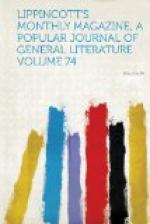The methods used in the teaching of articulation form a subject of much interest. The system has materially changed within the past few years. The first step to be taken is to convey a knowledge of the powers of the consonants and sounds of the vowels. Formerly, this was done by what was called the “imitation method.” The letter H was usually the point of attack, the aspirate being the simplest of all the powers of the letters. The teacher, holding up the hand of the pupil, makes the aspirate by breathing upon his palm. This is soon imitated, and thus a starting-point is gained. The feeling produced upon the hand is the method of giving him an idea of the powers of the consonants. A later and better system is that called “visible speech.” This is a system of symbols representing positions of the mouth and tongue and all the organs of speech, and if the pupil does what the symbols direct he cannot help giving the powers of the letters correctly. By this method a more distinct and perfect articulation is gained, with one-half the labor of the other method. As fast as the powers of the letters are learned, the spelling of words is undertaken. Many words are pronounced perfectly after a few trials: others, however, often defy the most strenuous and persevering effort.
Entire mutes who undertake articulation are like hearing children endeavoring to keep up the full curriculum of a modern school and pursue the study of music in addition: the ordinary studies demand all the energies of the child. Articulation consumes much time and strength. Exceptional cases are of course to be found which are indeed a triumph of culture, but the great mass of the deaf and dumb must always be content with written language.




